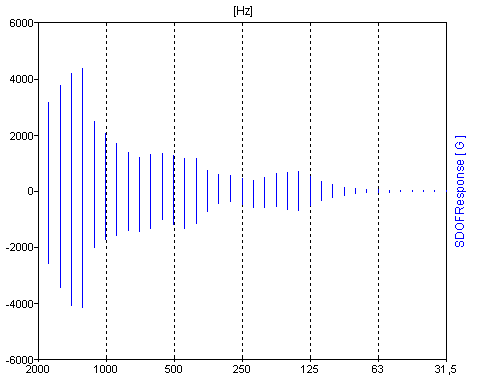SDOFResponse (FPScript)
Calculates the responses of individual single-degree-of-freedom (SDOF) systems of the SRS model from the signal of an acceleration sensor.
Syntax
SDOFResponse(Signal, [ DampingRatio = 0.05 ], [ StartingFrequency ], [ EndingFrequency ], [ FrequencyDivision = SRS_FREQUENCY_OCTAVE ], [ FrequencyResolution = 12 ] [ , Result = SRS_RESULT_ACCELERATION ])
The syntax of the SDOFResponse function consists of the following parts:
Part |
Description |
||||||||
|---|---|---|---|---|---|---|---|---|---|
Signal |
The data to be analyzed. The data must have a constant sampling rate and must not contain void values. Permitted data structures are data series und signal. All real data types are permitted. For the X component additional restrictions do apply.The values must have a constant positive spacing. If the argument is a list, then the function is executed for each element of the list and the result is also a list. |
||||||||
DampingRatio |
The damping ratio of the SDOF systems. The damping ratio is 1 / (2 * quality Q). Permitted data structures are scalar value. All real data types are permitted. The value must be greater or equal to 0.00001 and less or equal to 0.999999. If the argument is a list, then the first element in the list is taken. If this is also a list, then the process is repeated. If this argument is omitted, it will be set to the default value 0.05. |
||||||||
StartingFrequency |
The starting frequency for calculating the frequency series for the individual SDOF systems. The default value is 0.01 * sampling rate. Permitted data structures are scalar value. All real data types are permitted. The value must be greater or equal to 0.01 and less or equal to 10000. If the argument is a list, then the first element in the list is taken. If this is also a list, then the process is repeated. |
||||||||
EndingFrequency |
The ending frequency for calculating the maximum frequency of the SDOF frequency series. The maximum frequency is 0.1 * sampling rate. The default value is 0.1 * sampling rate. Permitted data structures are scalar value. All real data types are permitted. If the argument is a list, then the function is executed for each element of the list and the result is also a list. |
||||||||
FrequencyDivision |
Specifies the frequency division for calculating the frequency series for the individual SDOF systems. The argument FrequencyDivision can have the following values:
If the argument is a list, then the first element in the list is taken. If this is also a list, then the process is repeated. If this argument is omitted, it will be set to the default value SRS_FREQUENCY_OCTAVE. |
||||||||
FrequencyResolution |
Specifies the value for calculating the frequency range. The value specifies the number of frequencies per octave for the logarithmic frequency division. The value specifies the difference between two neighboring frequencies for the linear frequency division. Permitted data structures are scalar value. All real data types are permitted. If the argument is a list, then the first element in the list is taken. If this is also a list, then the process is repeated. If this argument is omitted, it will be set to the default value 12. |
||||||||
Result |
Specifies the result type of the function. You can request multiple results by adding the respective constants. The argument Result can have the following values:
Permitted data structures are scalar value. All integral data types are permitted. If the argument is a list, then the first element in the list is taken. If this is also a list, then the process is repeated. If this argument is omitted, it will be set to the default value SRS_RESULT_ACCELERATION. |
Remarks
The result always has the data structure signal series with Z-component.
The Z component outputs the calculated SDOF frequencies. If several result types are specified, then the result is a list.
Available in
Option Spectral Analysis
Examples
SDOFResponse(Acceleration, 6 %, 31.5 Hz, 2 kHz, SRS_FREQUENCY_OCTAVE, 6, SRS_RESULT_ACCELERATION)
Calculates the responses of individual single-degree-of-freedom (SDOF) systems of the SRS model from the 'Acceleration' signal (see the SRS function). A logarithmic frequency resolution (octave) between 31.5 Hz and 2000 Hz is used.
The following illustration shows a side view of the result. There are 6 signals per octave. With the help of the illustration, the maxima and minima can be seen across the entire time span.

